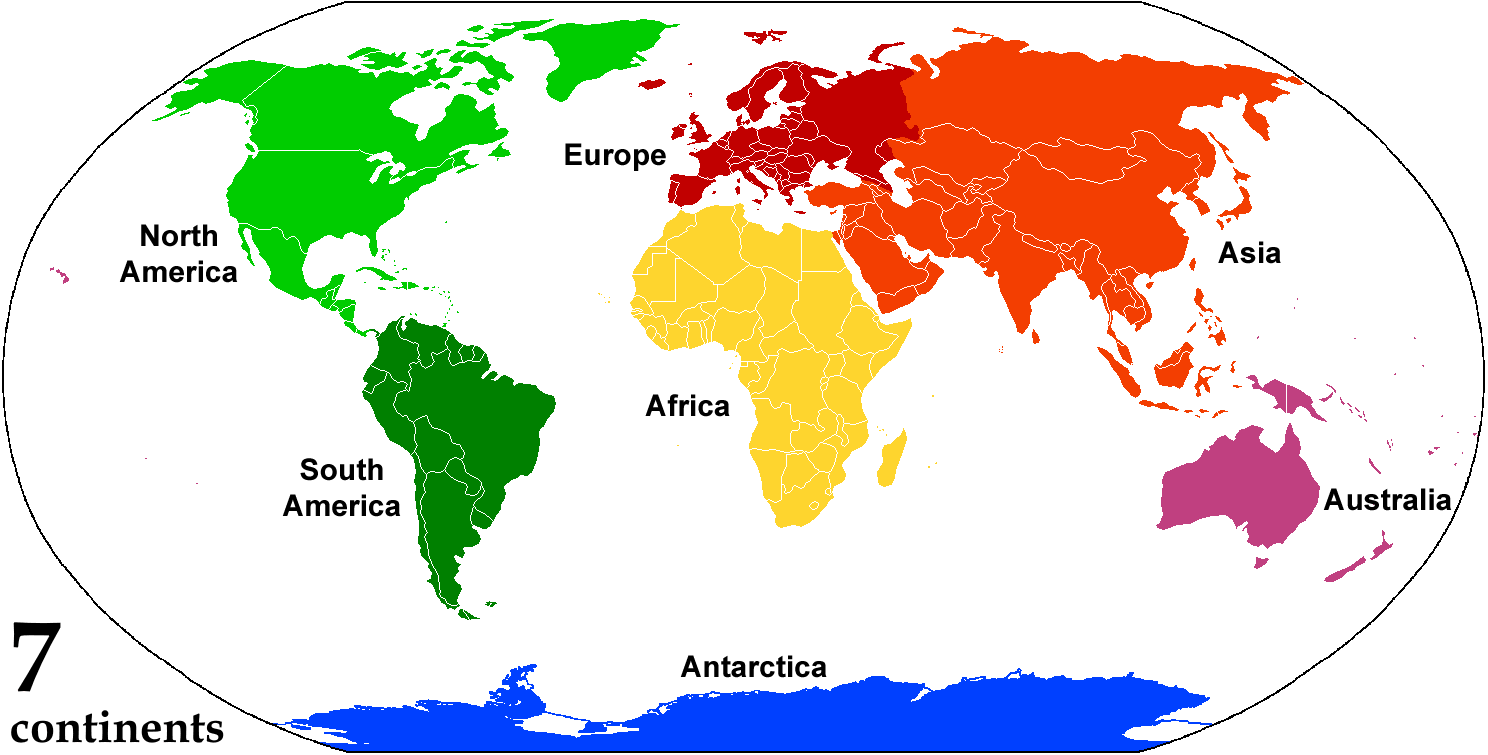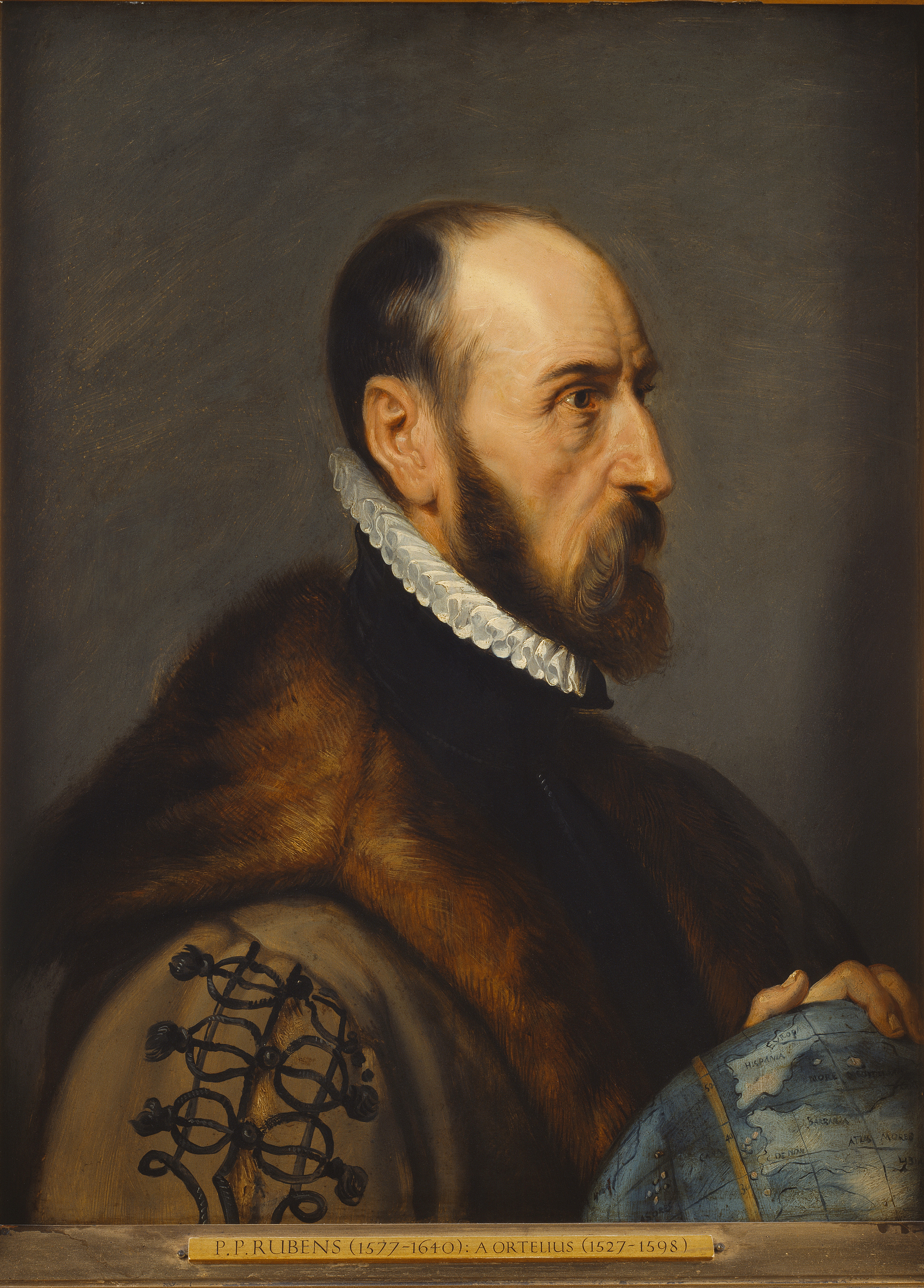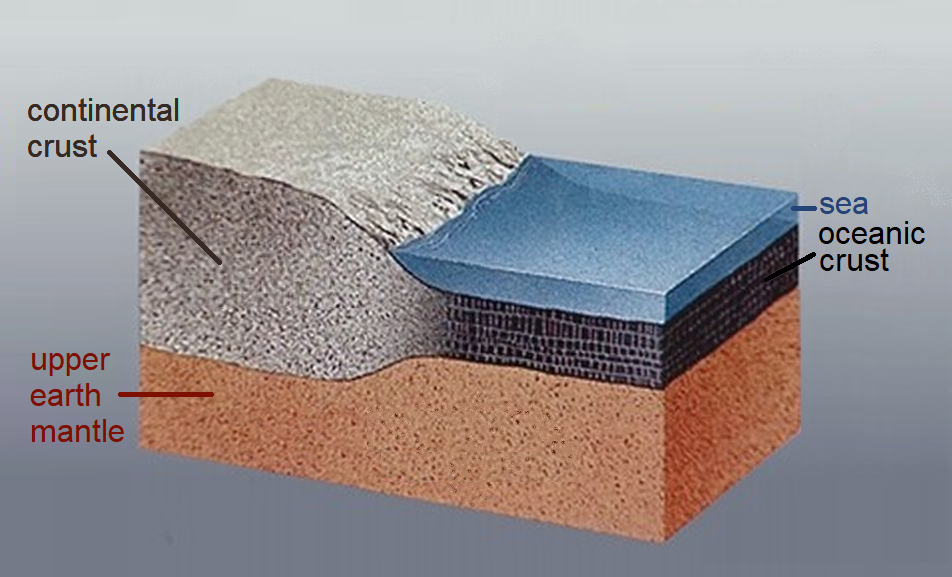|
Continent
A continent is any of several large geographical regions. Continents are generally identified by convention (norm), convention rather than any strict criteria. A continent could be a single large landmass, a part of a very large landmass, as in the case of Asia or Europe within Eurasia, or a landmass and nearby islands within its continental shelf. Due to these varying definitions, the number of continents varies; up to seven or as few as four geographical regions are commonly regarded as continents. Most English-speaking world, English-speaking countries recognize seven regions as continents. In order from largest to smallest in area, these seven regions are Asia, Africa, North America, South America, Antarctica, Europe, and Australia (continent), Australia (sometimes called Oceania or Australasia). Different variations with fewer continents merge some of these regions; examples of this are merging Asia and Europe into Eurasia, "Most people recognize seven continents—Asia, ... [...More Info...] [...Related Items...] OR: [Wikipedia] [Google] [Baidu] |
Australia (continent)
The continent of Australia, sometimes known in technical contexts as Sahul (), Australia-New Guinea, Australinea, or Meganesia to distinguish it from the Australia, country of Australia, is located within the Southern Hemisphere, Southern and Eastern Hemisphere, Eastern hemispheres, near the Maritime Southeast Asia. The continent includes mainland Australia, Tasmania, the island of New Guinea (Papua New Guinea and Western New Guinea), the Aru Islands Regency, Aru Islands, the Ashmore and Cartier Islands, most of the Coral Sea Islands, and some other list of islands of Australia, nearby islands. Situated in the geographical region of Oceania, more specifically in the subregion of Australasia, Australia is the Continent#Area and population, smallest of the seven traditional continents. The continent includes a continental shelf overlain by shallow seas which divide it into several landmasses—the Arafura Sea and Torres Strait between mainland Australia and New Guinea, and Bass ... [...More Info...] [...Related Items...] OR: [Wikipedia] [Google] [Baidu] |
Oceania
Oceania ( , ) is a region, geographical region including Australasia, Melanesia, Micronesia, and Polynesia. Outside of the English-speaking world, Oceania is generally considered a continent, while Mainland Australia is regarded as its continental landmass. Spanning the Eastern Hemisphere, Eastern and Western Hemisphere, Western hemispheres, at the centre of the land and water hemispheres, water hemisphere, Oceania is estimated to have a land area of about and a population of around 46.3 million as of 2024. Oceania is the smallest continent in land area and the list of continents and continental subregions by population, second-least populated after Antarctica. Oceania has a diverse mix of economies from the developed country, highly developed and globally competitive market economy, financial markets of Australia, French Polynesia, Hawaii, New Caledonia, and New Zealand, which rank high in quality of life and Human Development Index, to the much least developed countries ... [...More Info...] [...Related Items...] OR: [Wikipedia] [Google] [Baidu] |
Europe
Europe is a continent located entirely in the Northern Hemisphere and mostly in the Eastern Hemisphere. It is bordered by the Arctic Ocean to the north, the Atlantic Ocean to the west, the Mediterranean Sea to the south, and Asia to the east. Europe shares the landmass of Eurasia with Asia, and of Afro-Eurasia with both Africa and Asia. Europe is commonly considered to be Boundaries between the continents#Asia and Europe, separated from Asia by the Drainage divide, watershed of the Ural Mountains, the Ural (river), Ural River, the Caspian Sea, the Greater Caucasus, the Black Sea, and the waterway of the Bosporus, Bosporus Strait. "Europe" (pp. 68–69); "Asia" (pp. 90–91): "A commonly accepted division between Asia and Europe ... is formed by the Ural Mountains, Ural River, Caspian Sea, Caucasus Mountains, and the Black Sea with its outlets, the Bosporus and Dardanelles." Europe covers approx. , or 2% of Earth#Surface, Earth's surface (6.8% of Earth's land area), making it ... [...More Info...] [...Related Items...] OR: [Wikipedia] [Google] [Baidu] |
Continental Drift
Continental drift is a highly supported scientific theory, originating in the early 20th century, that Earth's continents move or drift relative to each other over geologic time. The theory of continental drift has since been validated and incorporated into the science of plate tectonics, which studies the movement of the continents as they ride on plates of the Earth's lithosphere. The speculation that continents might have "drifted" was first put forward by Abraham Ortelius in 1596. A pioneer of the modern view of mobilism was the Austrian geologist Otto Ampferer. The concept was independently and more fully developed by Alfred Wegener in his 1915 publication, "The Origin of Continents and Oceans". However, at that time his hypothesis was rejected by many for lack of any motive mechanism. In 1931, the English geologist Arthur Holmes proposed mantle convection for that mechanism. History Early history Abraham Ortelius , Theodor Christoph Lilienthal (1756), Alexan ... [...More Info...] [...Related Items...] OR: [Wikipedia] [Google] [Baidu] |
Pangaea
Pangaea or Pangea ( ) was a supercontinent that existed during the late Paleozoic and early Mesozoic eras. It assembled from the earlier continental units of Gondwana, Euramerica and Siberia during the Carboniferous period approximately 335 million years ago, and began to break apart about 200 million years ago, at the end of the Triassic and beginning of the Jurassic. Pangaea was C-shaped, with the bulk of its mass stretching between Earth's northern and southern polar regions and surrounded by the superocean Panthalassa and the Paleo-Tethys and subsequent Tethys Oceans. Pangaea is the most recent supercontinent to have existed and was the first to be reconstructed by geologists. Origin of the concept The name "Pangaea" is derived from Ancient Greek ''pan'' (, "all, entire, whole") and '' Gaia'' or Gaea (, " Mother Earth, land"). The first to suggest that the continents were once joined and later separated may have been Abraham Ortelius in 1596. The concept that the c ... [...More Info...] [...Related Items...] OR: [Wikipedia] [Google] [Baidu] |
North America
North America is a continent in the Northern Hemisphere, Northern and Western Hemisphere, Western hemispheres. North America is bordered to the north by the Arctic Ocean, to the east by the Atlantic Ocean, to the southeast by South America and the Caribbean Sea, and to the south and west by the Pacific Ocean. The region includes Middle America (Americas), Middle America (comprising the Caribbean, Central America, and Mexico) and Northern America. North America covers an area of about , representing approximately 16.5% of Earth's land area and 4.8% of its total surface area. It is the third-largest continent by size after Asia and Africa, and the list of continents and continental subregions by population, fourth-largest continent by population after Asia, Africa, and Europe. , North America's population was estimated as over 592 million people in list of sovereign states and dependent territories in North America, 23 independent states, or about 7.5% of the world's popula ... [...More Info...] [...Related Items...] OR: [Wikipedia] [Google] [Baidu] |
Continental Crust
Continental crust is the layer of igneous, metamorphic, and sedimentary rocks that forms the geological continents and the areas of shallow seabed close to their shores, known as '' continental shelves''. This layer is sometimes called '' sial'' because its bulk composition is richer in aluminium silicates (Al-Si) and has a lower density compared to the oceanic crust, called '' sima'' which is richer in magnesium silicate (Mg-Si) minerals. Changes in seismic wave velocities have shown that at a certain depth (the Conrad discontinuity), there is a reasonably sharp contrast between the more felsic upper continental crust and the lower continental crust, which is more mafic in character. Most continental crust is dry land above sea level. However, 94% of the Zealandia continental crust region is submerged beneath the Pacific Ocean, with New Zealand constituting 93% of the above-water portion. Thickness and density The continental crust consists of various layers, with ... [...More Info...] [...Related Items...] OR: [Wikipedia] [Google] [Baidu] |
Continental Fragment
Continental crustal fragments, partly synonymous with microcontinents, are pieces of continents that have broken off from main continental masses to form distinct islands that are often several hundred kilometers from their place of origin. Causes Continental fragments and microcontinent crustal compositions are very similar to those of regular continental crust. The rifting process that caused the continental fragments to form most likely impacts their layers and overall thickness along with the addition of mafic intrusions to the crust. Studies have determined that the average crustal thickness of continental fragments is approximately . The sedimentary layer of continental fragments can be up to thick and can overlay two to three crustal layers. Continental fragments have an average crustal density of which is very similar to that of typical continental crust. Strike-slip fault zones cause the fragmentation of microcontinents. The zones link the extensional zones where co ... [...More Info...] [...Related Items...] OR: [Wikipedia] [Google] [Baidu] |
Continental Shelf
A continental shelf is a portion of a continent that is submerged under an area of relatively shallow water, known as a shelf sea. Much of these shelves were exposed by drops in sea level during glacial periods. The shelf surrounding an island is known as an "''insular shelf''." The continental margin, between the continental shelf and the abyssal plain, comprises a steep continental slope, surrounded by the flatter continental rise, in which sediment from the continent above cascades down the slope and accumulates as a pile of sediment at the base of the slope. Extending as far as 500 km (310 mi) from the slope, it consists of thick sediments deposited by turbidity currents from the shelf and slope. The continental rise's gradient is intermediate between the gradients of the slope and the shelf. Under the United Nations Convention on the Law of the Sea, the name continental shelf was given a legal definition as the stretch of the seabed adjacent to the shores ... [...More Info...] [...Related Items...] OR: [Wikipedia] [Google] [Baidu] |
South America
South America is a continent entirely in the Western Hemisphere and mostly in the Southern Hemisphere, with a considerably smaller portion in the Northern Hemisphere. It can also be described as the southern Subregion#Americas, subregion of the Americas. South America is bordered on the west by the Pacific Ocean, on the north and east by the Atlantic Ocean, and to the south by the Drake Passage; North America and the Caribbean Sea lie to the northwest. The continent includes twelve sovereign states: Argentina, Bolivia, Brazil, Chile, Colombia, Ecuador, Guyana, Paraguay, Peru, Suriname, Uruguay, and Venezuela; two dependent territory, dependent territories: the Falkland Islands and South Georgia and the South Sandwich Islands; and one administrative division, internal territory: French Guiana. The Dutch Caribbean ABC islands (Leeward Antilles), ABC islands (Aruba, Bonaire, and Curaçao) and Trinidad and Tobago are geologically located on the South-American continental shel ... [...More Info...] [...Related Items...] OR: [Wikipedia] [Google] [Baidu] |
Asia
Asia ( , ) is the largest continent in the world by both land area and population. It covers an area of more than 44 million square kilometres, about 30% of Earth's total land area and 8% of Earth's total surface area. The continent, which has long been home to the majority of the human population, was the site of many of the first civilisations. Its 4.7 billion people constitute roughly 60% of the world's population. Asia shares the landmass of Eurasia with Europe, and of Afro-Eurasia with both Europe and Africa. In general terms, it is bounded on the east by the Pacific Ocean, on the south by the Indian Ocean, and on the north by the Arctic Ocean. The border of Asia with Europe is a social constructionism, historical and cultural construct, as there is no clear physical and geographical separation between them. A commonly accepted division places Asia to the east of the Suez Canal separating it from Africa; and to the east of the Turkish straits, the Ural Mountains an ... [...More Info...] [...Related Items...] OR: [Wikipedia] [Google] [Baidu] |








